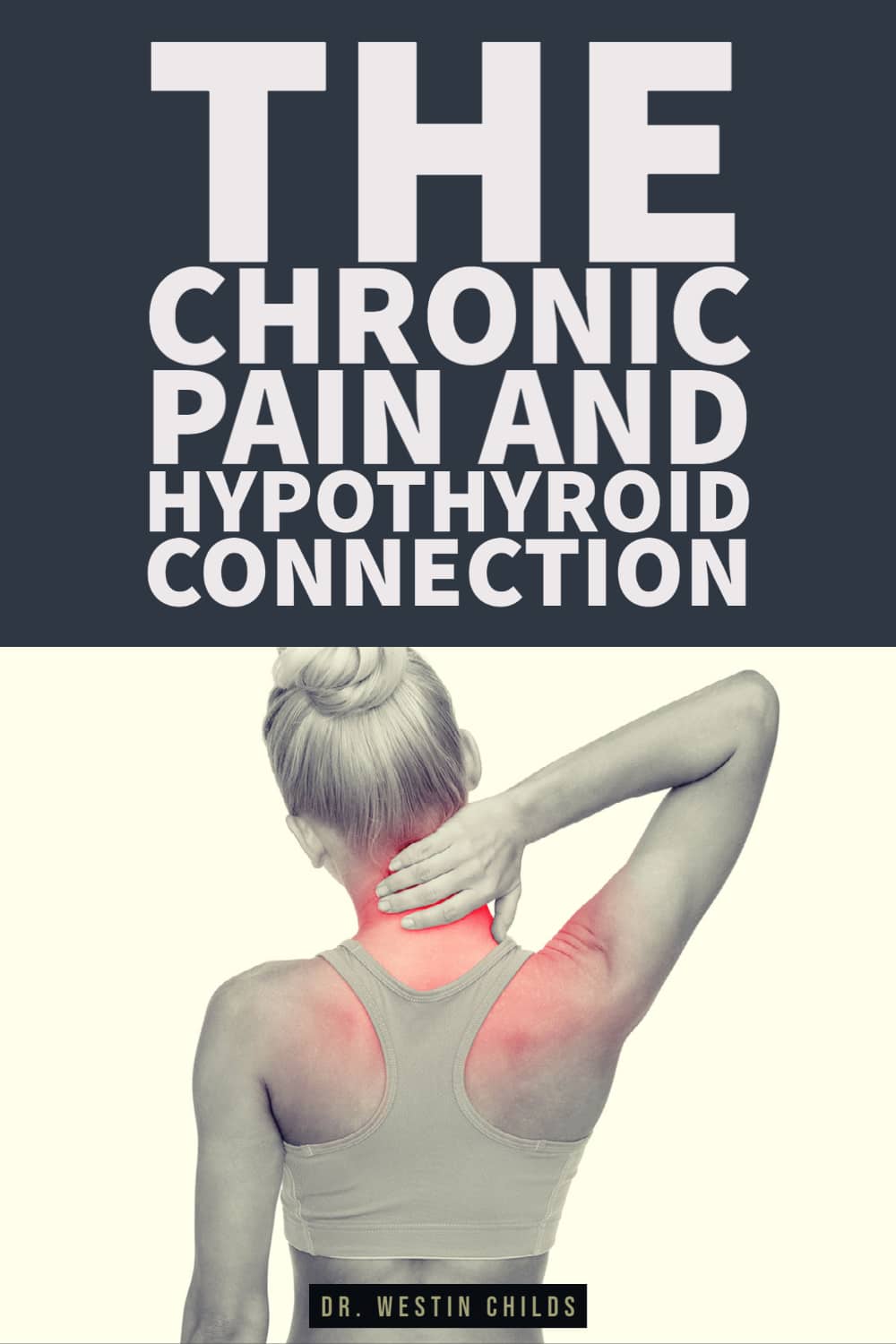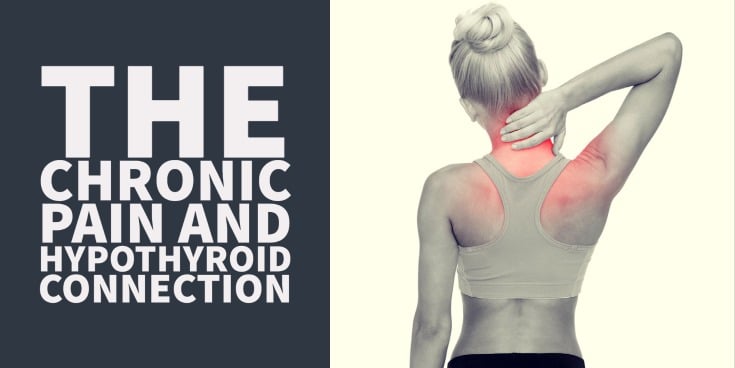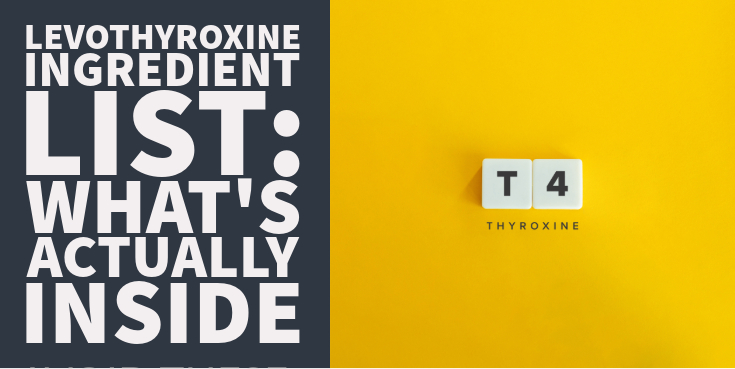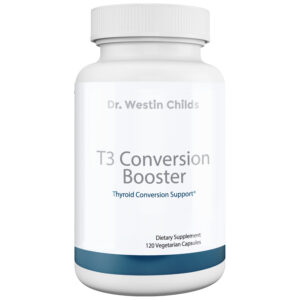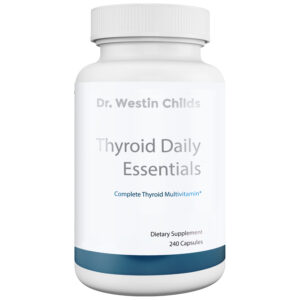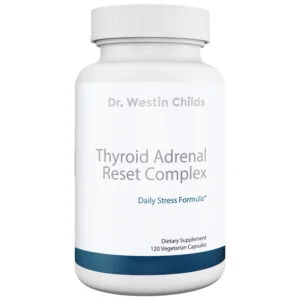Is your intuition telling you that your hypothyroidism or Hashimoto’s is causing your chronic pain?
I’ve got news for you:
Your intuition may be right.
Low thyroid hormone can potentiate musculoskeletal pain that can be misdiagnosed as fibromyalgia.
Even more important than that is many providers (and patients) don’t understand how to correctly diagnose, treat or manage pain and fibromyalgia related to hypothyroidism.
In this post, I’m going to talk about how hypothyroidism causes chronic pain and fibromyalgia, how to correctly diagnose the condition and other treatments that may help or benefit patients who suffer from this debilitating condition.
To understand how this works you really need to understand the concept of Tissue Level Hypothyroidism…
The Connection Between Hypothyroidism, Chronic Pain, and Fibromyalgia
You probably know that your thyroid helps to control the metabolism of your entire body but did you know that it also has many more functions than just that?
It’s common for patients who are hypothyroid to gain weight, but one of the other (many symptoms) of hypothyroidism includes chronic musculoskeletal pain.
In fact, it’s not uncommon for hypothyroid patients to present with back pain, joint pain or multiple tender points deep in their muscular tissue (1).
While hypothyroidism can cause chronic pain and a fibromyalgia-like syndrome this doesn’t mean that ALL cases of fibromyalgia and chronic pain are due to hypothyroidism.
That being said…
If you have either condition (chronic pain syndrome, fibromyalgia or chronic fatigue syndrome) you absolutely should have your thyroid checked out.
And I don’t mean a cursory glance at your TSH, I mean a complete thyroid panel and thorough workup that includes ALL thyroid lab tests including markers for autoimmune thyroiditis.
I hear patients all the time respond that their thyroid is “fine” only to find out upon closer look it’s anything but fine.
Before we talk about how to correctly diagnose thyroid issues we need to talk about how thyroid hormone can cause chronic pain and fibromyalgia.
Bottom line: Hypothyroidism can certainly cause and potentiate chronic pain and fibromyalgia. Standard blood tests and standard “interpretation” of thyroid lab studies is insufficient to correctly diagnose the problem. To properly evaluate for this condition you need a complete set of lab tests and proper workup.
DOWNLOAD FREE RESOURCES
Foods to Avoid if you Have Thyroid Problems:
I’ve found that these 10 foods cause the most problems for thyroid patients. Learn which foods you should avoid if you have thyroid disease of any type.
The Complete List of Thyroid Lab tests:
The list includes optimal ranges, normal ranges, and the complete list of tests you need to diagnose and manage thyroid disease correctly!
Tissue Level Hypothyroidism Explained
So what can cause “normal” thyroid lab tests but all the symptoms of hypothyroidism?
This condition is known as tissue level hypothyroidism (2).
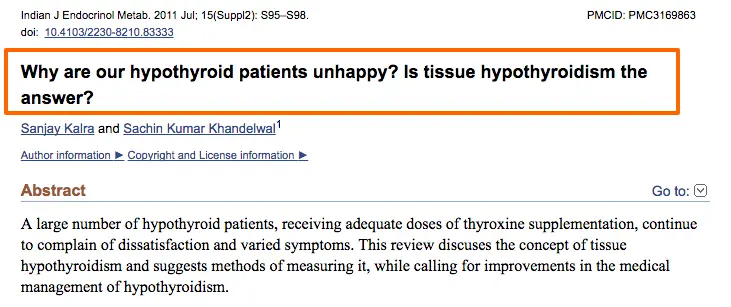
Tissue-level hypothyroidism may explain why there is widespread dissatisfaction with standard thyroid treatment and standard thyroid replacement therapy with Levothyroxine or Synthroid.
It turns out that there are many patients currently being treated with thyroid hormone and yet they still have all of the symptoms of hypothyroidism, including chronic pain, hair loss, weight gain, and weight loss resistance.
So what is tissue-level hypothyroidism and how does it cause these symptoms?
Tissue level hypothyroidism is the idea that you as the patient might have “normal” blood levels of thyroid hormone but due to a number of factors (including inflammation, weight gain, medications, chronic illness, etc.), that thyroid hormone can’t get into the cells to do its job.
So it remains outside of the cell in the bloodstream making it look like your thyroid function is fine but in reality that thyroid hormone is almost inactive.
This is also known as thyroid resistance and it is probably one of the most commonly missed thyroid conditions due to how thyroid diseases are diagnosed.
Standard laboratory tests can only measure what is happening in the bloodstream.
But…
When it comes to thyroid hormone, we don’t care what’s happening in the bloodstream because thyroid hormone has to get into cells to do its job.
Thyroid hormone is active when it travels through the cell membrane and directly attaches to the nucleus to what’s known as a nuclear receptor (3).

From there it directly changes your DNA, in a process called genetic transcription, and causes an increase in metabolism, changes in proteins, and an increase in oxygen consumption (4).
Pretty cool, right?
This means that in order to properly check if thyroid hormone is working, we really need to look at both the blood levels of thyroid hormone and markers to see if it is actually working in the cell.
One of the best ways to do this is by looking at the complete thyroid blood panel.
Bottom line: It’s possible for you to have “normal” levels of thyroid hormone floating around in your blood but that hormone is only active IF it can get inside your cells and turn on genetic transcription and change your DNA. Some patients have “normal” blood levels but that hormone can’t get into the cells to do its job – this is known as tissue-level hypothyroidism.
The Complete Thyroid Blood Panel
The only way to correctly diagnose and identify tissue-level hypothyroidism is with a complete thyroid blood panel.
This panel is designed to not only evaluate how much thyroid hormone is floating around in the blood but also evaluate if the tissues and cells are getting enough thyroid hormone.
The complete thyroid blood panel you need to use if you have Chronic pain or Fibromyalgia:
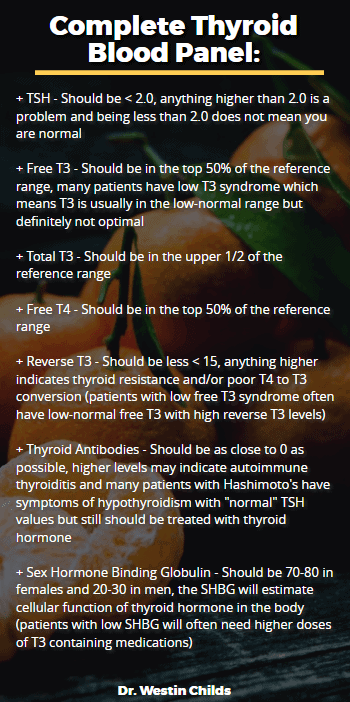
- TSH: Should be less than 2.0 – this helps determine how much thyroid hormone is influencing pituitary function
- Free T3: Should be in the upper 50% of the reference range (patients with fibromyalgia and chronic pain often have VERY low free T3 levels)
- Reverse T3: Should be less than 15 (the higher your reverse T3 and the lower your Free T3 the more symptoms you will have)
- Free T3/Reverse T3 ratio: Should be greater than 0.2 when you divide both numbers (Chronic dieting leads to thyroid resistance and can worsen thyroid function)
- Total T3: Should be in the upper 50% of the reference range (usually in the 130-150 range
- Sex Hormone Binding Globulin: In women, this should be between 70 to 80 (This protein is secreted from the liver when thyroid hormone is present and active so it can be used as a surrogate marker for thyroid tissue levels)
- Thyroid Antibodies: Should be as close to 0 as possible (high levels may indicate autoimmune thyroiditis and inflammatory conditions)
When most providers and Doctors check thyroid function they are usually checking just the TSH.
Without the other markers and the “optimal” reference ranges it is difficult to truly diagnose tissue-level hypothyroidism.
I hope now you can see why many patients are told their thyroid function is “normal” and yet that is not true at all.
Bottom line: If you have chronic pain or fibromyalgia make sure you get the complete thyroid blood panel and you evaluate your thyroid function based on the “optimal” reference ranges.
The Link Between Fibromyalgia, Chronic Pain, and Hypothyroidism
Chronic pain and Fibromyalgia frequently accompany each other, however, no one seems to understand the exact connection.
But, if you look at the symptoms of Fibromyalgia and Hypothyroidism side by side you begin to see something very interesting:
Fibromyalgia and Hypothyroidism present with almost the exact same symptoms…
There are several studies to show this (which we will go over below) but first I want to talk about a researcher named Dr. Lowe who put this all together for us.
He linked tissue-level hypothyroidism as one of the main causes of Fibromyalgia. And he did this through a concept known as ‘deductively formulated theory‘.
This method of problem-solving takes all of the competing theories that cause disease and, by the use of mathematical analysis, pumps out the hypothesis that is most likely to be correct (this is the same logic that Albert Einstein used to come up with his hypotheses, like the theory of relativity (5)).
Not only did he link the two conditions together he also showed us how to effectively treat and even reverse Fibromyalgia and chronic pain symptoms through various research studies and even case studies.
Through his research, he found that the majority of patients who have fibromyalgia either have undiagnosed hypothyroidism or are inadequately treated with LT4-containing medications.
His research showed that in order for patients to have complete remission of their pain most of them needed the active form of thyroid hormone known as T3.
This can be assessed through routine blood work but it is not often ordered by most physicians.
For this reason, you may need to specifically ask your doctor to check your free T3, total T3, and reverse T3 levels in order to accurately assess if your body has sufficient cellular thyroid hormone available.
As a quick primer:
T4 is the inactive thyroid hormone that must be converted to T3 to become active <—- This is what most Doctors prescribe for patients
T3 is the active thyroid hormone that turns on genetic transcription, increases metabolism, and helps thyroid patients feel better <—- Most Doctors do not prescribe this medication but many patients with chronic pain and fibromyalgia may need it
Dr. Lowe’s data showed that approximately 2/3 of patients improved on Natural Desiccated Thyroid Hormone (Medications like Armour thyroid, WP Thyroid, and Nature-throid) and another 1/3 required higher doses of T3-only therapy (Liothyronine or sustained release T3) to get symptomatic improvement.
While thyroid hormone that contains T3 (triiodothyronine) was very important to treating and reversing fibromyalgia, it wasn’t the only therapy required to get complete remission.
We will go over the rest of the treatment below, but first, let’s talk about some of the symptoms you might be experiencing if you have tissue-level hypothyroidism.
Symptoms of Tissue level Hypothyroidism & Fibromyalgia
As I mentioned previously blood tests are not 100% accurate in diagnosing hypothyroidism which leads to many undiagnosed and/or mismanaged patients.
It turns out that using the combination of symptoms in combination with blood tests makes diagnosis much more reliable.
Before the widespread use of TSH testing most patients were diagnosed by symptoms alone and their medication was also titrated based off of their symptoms.
While there are hundreds of symptoms of hypothyroidism there are a few that remain very constant among patients who share both fibromyalgia and hypothyroidism which we will go over below:
#1. Chronic Fatigue
This is the kind of fatigue that is debilitating. The kind of fatigue that keeps you from doing normal activities like household chores or going out.
Patients frequently tell me that after they go out to do something simple like shopping they are almost bed bound for 1-2 days.
Chronic fatigue is both a symptom of hypothyroidism and fibromyalgia, but how are they connected?
2 ways:
Thyroid hormone is involved in the production of Dopamine.
Dopamine helps your body to determine how much energy it is going to use and low levels have been associated with obesity (6).
If you have low levels of thyroid hormone you will have low levels of Dopamine which will result in the symptom of Chronic Fatigue.
Thyroid hormone helps your body convert Tyrosine to Dopamine, Norepinephrine, and Epinephrine.
You may know some of these hormones as adrenaline (7) which helps to set the metabolism of your body and is required for the “fight or flight” response.
The second way hypothyroidism causes fatigue is through decreased consumption of oxygen and thus decreased production of ATP.
ATP is created in the mitochondria of your cells, if you have low production of ATP you will have the subjective symptom of fatigue.
Thyroid hormone is involved in the metabolism of oxygen and oxygen consumption is required for proper ATP production.
#2. Weight Gain, Weight Loss Resistance & Inability to Lose Weight
Does it feel like you are constantly gaining weight, despite eating healthy or even exercising?
Many hypothyroid patients and fibromyalgia patients have difficulty with weight loss even though many of them are already restricting calories and exercising frequently.
This isn’t a normal condition and it can be mediated through low levels of thyroid hormone in the body.
Under normal circumstances, thyroid hormone helps your body burn fat by increasing the effectiveness of lipolytic enzymes (8)(enzymes that break down fat).
When thyroid hormone is low, these enzymes are also low resulting in the inability to break down fat molecules – making it almost impossible to lose weight.
(Thyroid hormone increases enzymes that help you burn fat and when thyroid levels are low your cholesterol increases and your metabolism will slow down)
In addition, thyroid hormone is involved in mediating your basal metabolic rate or resting energy expenditure (9).
In other words, thyroid hormone helps regulate your metabolism.
Patients with hypothyroidism frequently feel like their metabolism is damaged and may gain weight even when eating 1200-1500 calories per day (sometimes even less).
In order to fix this metabolic damage thyroid hormone must be replaced.
#3. Hair Loss
Many patients with fibromyalgia have symptoms of hair loss and/or hair thinning.
It is well known that thyroid hormone is required for both hair growth and proper pigmentation (10).
Now hypothyroidism isn’t the only cause of hair loss but it is definitely one of the more common causes.
Chronic stress itself can lead to hair loss and let’s face it: having fibromyalgia is stressful.
But hypothyroidism is still a leading cause.
Not only that but low thyroid hormone leads to low stomach acid which leads to nutrient deficiencies that make hair growth even more difficult.
Deficiencies in zinc, B12, and iron cause both hair loss and are made worse by hypothyroidism.
(Low thyroid hormone leads to hair loss by itself but also leads to deficiencies of nutrients required for hair growth – it’s a double whammy)
Just realize that replacing these nutrient deficiencies is a necessary and important part of reducing symptoms of both fibromyalgia and hypothyroidism.
#4. Muscle Tension, Trigger Points & Muscular Pain
Tender points in the muscles are common in fibromyalgia.
These tender points are caused by abnormal contractions in the muscular tissue that stays contracted over long periods of time causing changes in the fascia and potentiating pain.
In order to relieve the pain, the tissue MUST relax, and in order for muscular tissue to contract, there must be enough energy in the form of ATP.
Remember that thyroid hormone is required for proper ATP production?
In order for muscles to relax your body must produce ATP (11)(the energy currency in your body).
What you may not realize is that contracting your muscles does not use energy, it’s the relaxation portion that requires energy.
Consider this as an example:
When someone dies all of their muscles contracts and they become “stiff”, this is known as rigor mortis (12).
The reason for this contraction is a lack of energy production.
The same thing is happening (to a smaller degree) in certain muscles in patients with chronic pain, fibromyalgia, and hypothyroidism.
This inability to relax your muscles results in trigger point formation and muscle tension/pain (13).
Treating these trigger points and tender points is required for the relief of pain and we will go over that below.
#5. Delayed Relaxation Phase of Deep Tendon Reflexes
This symptom you may not even realize you have, but it can be a VERY sensitive marker for diagnosing tissue-level hypothyroidism.
When tissue levels of thyroid are low it results in the inability of your muscles to relax quickly which causes a slow relaxation phase when checking deep tendon reflexes (14).
Your reflexes have been tested whether you realize it or not:
Testing of the deep tendon reflexes happens when your Doctor hits your knee with his reflex hammer and your knee automatically “jumps”.
Patients with a low amount of thyroid hormone in their tissues have a slower response to the relaxation portion when this reflex is tested (15).
This can be easily tested and there are even machines to help with the diagnosis.
How to Treat & Reverse Fibromyalgia & Hypothyroidism:
These recommendations come from treating many patients with chronic pain, fibromyalgia, and hypothyroidism.
You can see an example of a case study in a patient with chronic pain who had a complete resolution in her symptoms, lost 40+ pounds, and reversed her diabetes here.
This treatment works (provided your symptoms are due to hypothyroidism) and has the potential to help many patients if done correctly.
For the best results make sure to follow each of the recommendations below – doing just one or two of them will not lead to long-lasting, significant results.
Step #1: Get on the right type and dose of thyroid medication
For most patients, this means using some form of T3 thyroid medication.
The majority of patients are already on T4-only medication (such as Synthroid, levothyroxine, or Tirosint) but in order to ensure that tissues are getting enough thyroid hormone, you will need T3 added to your regimen.
If you have a diagnosis of hypothyroidism you can follow these steps:
- Add T3 (in the form of liothyronine or cytomel) to your existing medication – you can ask your provider for this medication (this is probably the easiest way to get T3)
- Switch from levothyroxine to NDT —> this may be difficult but some providers are willing to do it. Make sure you follow this dosing guide if switching.
- Temporarily (or permanently) switch to T3-only medication <— this will be the most difficult to get but probably the most effective
If you don’t have a diagnosis of hypothyroidism then I recommend these steps:
- Check a complete thyroid blood panel
- Check your symptoms using this complete list of hypothyroid symptoms
- Consider checking your basal body temperature and resting heart rate (low body temp and low resting pulse may indicate hypothyroidism)
- Find a provider willing to order these tests and treat appropriately (see medications above)
Step #2: Exercise to tolerance
The important part of this step is to find the maximum that you can tolerate and exercise to that point.
This will vary depending on your energy level, your weight, and your metabolism.
If you can only exercise for 5-10 minutes once per week, then that’s fine. On the other hand, if you can tolerate 20-30 minutes several times per week then you should do that.
Focus on taking your body to its limits and exhausting the targeted muscle group of both glycogen and energy.
This can be done most efficiently by utilizing the idea of high-intensity interval training or high-intensity strength training (16).
Both exercises provide benefits over the traditional “cardio” type workouts where you sit on the treadmill for 45-60 minutes a few times per week.
The more intense your work out the better it is for muscular tissue, energy levels, and hormones.
It also provides a boost to weight loss.
Step #3: Eat a real, whole food, nutritious diet
Diet is an important part of treatment and the basics should include real, whole, and nutritious food.
The macromolecule breakdown of your diet should be tailored to your body, your activity level, and other specific medical problems you may have.
Real whole food diets include diets like whole30, the paleo diet, and even nutritional ketosis.
You can find more information about how to pick your diet in these posts:
If you are new to the idea of changing up your diet take it slow but use the recommendations in the articles above to help get you started.
Changing your diet will be required for optimal health.
Step #4: Manage muscular tension with these recommendations
As we discussed previously treating and “releasing” the tender points seen in fibromyalgia and chronic pain are required to reduce symptoms.
Treating these tender points involves several therapies but universally some sort of mechanical force will be required to get rid of them.
I recommend and have used all of the following therapies for patients with fibromyalgia:
- Manual massage (17) <—- this can be a deep tissue massage or medical massage.
- Vibration therapy including handheld vibratory devices designed for musculoskeletal tension or whole body vibration machines (18).
- Trigger point injection therapy <— studies have shown (19) injection therapy to provide significant relief to pressure and pain points.
- Myofascial release (20) and other soft tissue techniques.
Studies have shown (21) that various types of massages improve the quality of life in patients with fibromyalgia.
Whatever you decide to do just make sure you remain consistent with the therapy while doing the other treatment recommendations.
Step #5: Replace nutritional deficiencies
Most people nowadays have some vitamin and nutrient deficiencies as a result of chronic stress and poor nutritional diet.
Replacing these nutrient deficiencies is a vital part of the healing process and in most cases is required to thrive.
Hypothyroid patients (and fibromyalgia) are susceptible to certain nutrient deficiencies that may potentiate chronic pain and fatigue.
For instance, studies have shown (22) that fibromyalgia patients tend to have a low mineral content via hair analysis.
You can read more about the list of nutrients that hypothyroid patients need to function optimally here.
Below I will also go over the most important nutrients required for energy and to reduce pain & inflammation:
- B complex vitamins <—- B vitamins (specifically B6 and B12) are required for proper energy production and replacing them may improve energy levels and reduce fatigue. When replacing vitamin B12 make sure to consider B12 shots if you have issues with absorption.
- Zinc & Selenium <—- Zinc reduces inflammation and is required for proper immunity, it also helps boost T4 to T3 conversion and helps the thyroid function optimally.
- Iron <—- Iron deficiency leads to hair loss, decreased energy, and even shortness of breath. Low levels are seen in patients with hypothyroidism, but be careful when supplementing not to get “too much”. You can follow iron storage in your body by assessing your ferritin level.
- Krill oil + Astaxanthin <—- Omega 3 fatty acids help to reduce inflammation (23) and provide relief to patients with joint pain and chronic pain syndrome.
Bottom line: Replacing nutrient deficiencies is a necessary part of recovering from chronic pain and fibromyalgia. Make sure to target your nutrient replacement to targeted deficiencies based on lab tests.
Conclusion
What’s the main takeaway here?
If you are suffering from chronic pain or fibromyalgia, and you also have hypothyroidism, then there may be a connection between the two.
Due to how hypothyroidism is managed, however, your physician may not be aware of this connection and you may not receive adequate treatment.
It appears that chronic pain can be made worse by low levels of circulating thyroid hormone.
The treatment for this condition is to use thyroid medications that contain both the active T3 and the inactive T4 hormones.
To ensure that you are getting enough thyroid hormone you need to get a full thyroid lab panel and look specifically at the concentrations of free thyroid hormone in your blood.
Once you have this data you can then determine how to proceed with treatment!
In addition to using thyroid medication, you’ll also want to focus on repleting any lost nutrients, using a proper exercise routine and on eating a healthy and nutritious diet.
All of these things, when combined, may help to relieve your pain.
Now I want to hear from you:
Are you suffering from chronic pain and/or fibromyalgia?
Have you been able to overcome your symptoms?
Do you also have hypothyroidism?
Let us know what worked (and what didn’t work) for you so we can further the cause and help as many people as possible.
Leave your comments or questions below!
Scientific References
#1. https://www.ncbi.nlm.nih.gov/pubmed/24435355
#2. https://www.ncbi.nlm.nih.gov/pmc/articles/PMC3169863/
#3. https://www.ncbi.nlm.nih.gov/pmc/articles/PMC329808/
#4. https://www.ncbi.nlm.nih.gov/pmc/articles/PMC329808/?page=1
#5. https://www.ncbi.nlm.nih.gov/pubmed/365000
#6. https://www.ncbi.nlm.nih.gov/pubmed/22833718
#7. https://www.ncbi.nlm.nih.gov/pubmed/28077337
#8. http://www.ncbi.nlm.nih.gov/pubmed/3335609
#9. https://www.ncbi.nlm.nih.gov/pubmed/9100583
#10. http://www.ncbi.nlm.nih.gov/pubmed/18728176
#11. https://www.ncbi.nlm.nih.gov/pmc/articles/PMC3360099/
#12. https://www.ncbi.nlm.nih.gov/pmc/articles/PMC1393748/
#13. https://www.ncbi.nlm.nih.gov/pmc/articles/PMC3440564/
#14. http://www.ncbi.nlm.nih.gov/pmc/articles/PMC2492977/
#15. https://www.ncbi.nlm.nih.gov/pmc/articles/PMC2466474/?page=1
#16. https://www.ncbi.nlm.nih.gov/pmc/articles/PMC2991639/
#17. https://www.ncbi.nlm.nih.gov/pubmed/25457196
#18. https://www.ncbi.nlm.nih.gov/pmc/articles/PMC4553315/
#19. https://www.ncbi.nlm.nih.gov/pubmed/16454721
#20. https://www.ncbi.nlm.nih.gov/pubmed/25603749
#21. https://www.ncbi.nlm.nih.gov/pubmed/25457196
#22. https://www.ncbi.nlm.nih.gov/pmc/articles/PMC3192333/
